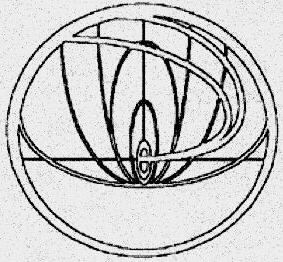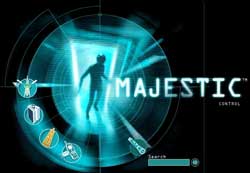An alternate reality game (ARG) is an interactive networked narrative that uses the real world as a platform and employs transmedia storytelling to deliver a story that may be altered by players' ideas or actions.

John Titor and TimeTravel_0 are pseudonyms used on internet forums between 2000 and 2001 by an individual claiming to be an American military time traveler from the year 2036. Their posts discussed various aspects of time travel, and described future calamitous events, including a global nuclear war. The uniform inaccuracy of their predictions and inconsistencies in their explanations has led many to view the story with skepticism. A 2009 investigation suggested that the entire affair was a hoax created by Larry Haber, a Florida entertainment lawyer, and his brother John Rick Haber, a computer scientist. These claims have never been verified.

Legend tripping is a name bestowed by folklorists and anthropologists on an adolescent practice in which a usually furtive nocturnal pilgrimage is made to a site which is alleged to have been the scene of some tragic, horrific, and possibly supernatural event or haunting. The practice mostly involves the visiting of sites endemic to locations identified in local urban legends. Legend tripping has been documented most thoroughly to date in the United States.
A shadow person is the perception of shadow as a living species, humanoid figure, sometimes interpreted as the presence of a spirit or other entity by believers in the paranormal or supernatural.

Ong's Hat is a ghost town in Pemberton Township, Burlington County, in the U.S. state of New Jersey. It is located on Magnolia Road west of the Four Mile Circle, where New Jersey Route 72 intersects with New Jersey Route 70. It is the northern terminus of the Batona Trail.

Majestic was one of the first alternate reality games (ARGs), a type of game that blurs the line between in-game and out-of-game experiences. Majestic was created by Neil Young. It debuted on July 24, 2001. While noted for its unusual concept, it did not fare well commercially.
Perplex City was an alternate reality game (ARG) created by Mind Candy, a London-based developer in 2005. Adrian Hon was the producer, designer and director of the game's first and only season, in which players searched for "The Receda Cube", an artifact of spiritual significance to the inhabitants of a fictional metropolis known as "Perplex City" which had great scientific value. In the game, "The Cube" had been stolen and buried somewhere on Earth.
Alternate reality games are a modern genre of gaming often consisting of an interactive, networked narrative that uses the real world as a platform and employs transmedia storytelling to deliver a story that may be altered by players' ideas or actions. Most of these games are either independently run or used as a viral marketing campaign by a company or brand.
Transmedia storytelling is the technique of telling a single story or story experience across multiple platforms and formats using current digital technologies.

Steve Peters is an American independent game designer and experience designer specializing in alternate reality games and transmedia storytelling. Steve was Chief Creative Officer at No Mimes Media, an Alternate Reality Game company which he co-founded with Maureen McHugh and Behnam Karbassi in March 2009. From 2011 to 2012, he was VP of Experience Design at Fourth Wall Studios, where he was Lead Experience Designer for their Emmy® Award-Winning series Dirty Work, among others. From 2012 through 2017, he hosted the StoryForward Podcast, a show that explored the future of storytelling and entertainment.
The Truth About Marika, is a transmedia production by Sveriges Television (SVT) and The company P in cooperation with SICS and Interactive Institute. It is an alternate reality game and a TV-series, created by Anders Weidemann, Martin Ericsson and Daniel Lägersten. The drama series, written by Anders Weidemann, first aired in Sweden during the autumn of 2007. The Truth About Marika was marketed as a "participation drama" and had a high amount of viewer participation.
Dave Szulborski was the first professional independent alternate reality game developer, and an authority on ARGs. His books on the subject are used today in curricula on alternate reality games and transmedia storytelling. His independent games included ChangeAgents, Chasing the Wish, and Urban Hunt. He holds the Guinness World Record for Most Prolific ARG developer.
Joseph Wayne Matheny is an American writer and transmedia artist who has created works using alternate reality gaming and transmedia storytelling methods. He holds patents for prediction, recommendation and behavioral analysis algorithms and software design. He is a published author of screenplays, white papers, technology, sci-fi, marketing and gaming books. He is probably best known for the avant-garde work Ong's Hat, which has been called the proto-Alternate Reality Game. Ong's Hat is often cited as the first ARG on many lists of alternate reality games.

Zenith is a 2010 American psychological thriller directed by Vladan Nikolic and starring Peter Scanavino, Jason Robards III, and Ana Asensio. The screenplay concerns two men attempting to solve the same conspiracy theory. The title refers to a grand 'Zenith Conspiracy' formed by the film's protagonist, Ed Crowley. The film also utilizes an alternate reality game and transmedia storytelling to augment its narrative.

Ken Eklund is an American game and experience designer known as Writerguy. He is perhaps most famous for World Without Oil, an early "serious game" in the alternate reality game genre he created and ran in 2007. His recent projects "explore the positive social effects of collaborative experiences and open-ended, creative play. "
Alice & Smith is a Canadian transmedia storytelling and video game developer that specializes in alternate reality games.
Adrian Hon is an English writer and game designer specializing in alternate reality games and transmedia storytelling. He is the CEO and founder of Six to Start, creator of the fitness game Zombies, Run!, and a non-fiction and sci-fi author.
No Players Online is a short horror game released on Itch.io, a website for indie games. It was created by Belgian university students Adam Pype and Ward D'Heer and sound designer Viktor Kraus as part of the Haunted PS1 Jam in November 2019. Initially intended to be a twenty-minute horror game, the developers continued to expand the game into an alternate reality game (ARG) involving cryptic messages and secret passcodes. Players quickly solved the ARG on a dedicated Discord server.
Christy Dena is an Australian writer, game designer, and scholar. Her scholarship and design practice in transmedia storytelling has been widely cited, especially for promoting the term "cross-media storytelling". She is also known for defining the term "transmedial fictions" for The Johns Hopkins Encyclopedia of Digital Textuality. She created her own studio, Universe Creation 101, where she creates original projects and does consultations and freelance work. She likes to combine live social experiences with online technology, traditional forms of screen and paper-based objects.